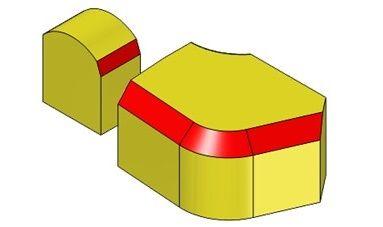
Parasolid v30.1 delivers enhancements across a broad front of classic B-rep functionality to enable application developers to code and maintain sophisticated functionality more effectively for their end-users. Facet B-rep enhancements cover complex modeling with facet data and repair of imported facet data, in addition to architectural foundations to support fully integrated Convergent Modeling in future releases.
Enhancements include:
Blends and Booleans
- Chamfer blend functionality is enhanced to support apex-range chamfer blends in both edge and face blending with constant ranges and angles. No specific edge selection is required and control is provided for chamfer angle and offset distance.
- Improved controls to support face blend preview.
-
-
Model Editing and Interrogation
A number of classic B-rep operations have been added to enable application developers to manage end-user workflows more easily, including:
- Creation of general wire bodies, perspective outlines and symmetric periodic B-curves.
- Mass properties of transformed topologies including reflections.
- Improved diagnostics for swept tool and fill hole.
- Increased case coverage in tapering when creating mitre faces
- Facet Enabled Modeling
-
A large number of specific, advanced classic B-rep operations have been enhanced to operate on facet B-rep geometry, including:
- Enhanced mesh blending and deleting chains of blends.
- Modeling operations such as performing dependent offsets, sewing, transforming faces, tapering faces, deleting faces and creating isocline taper surfaces from polylines.
- Boolean edge-edge matching and Euler operations.
- Intersections between facet B-rep faces and classic B-rep planes in addition to clashes between facet B-rep and classic B-rep entities.
-
Mesh-Specific Enhancements
Several enhancements have been added that are specific to working with mesh data including: - Returning sets of sharp mfins, indicating creases in a mesh surface. Creases are also returned as a new line type in rendering.
- Faceting general facet bodies, including output of connectivity information which is of particular use in CAE applications.
- Repair of tolerant slits between disjoint meshes in order to easily unite fragmented meshes into a single mesh.
- Improved performance, including better caching, for meshes with many facets.
- Embedded mesh data in XT files.
- Incremental faceting of facet B-rep models.
Contact Details
Related Glossary Terms
- computer-aided engineering ( CAE)
computer-aided engineering ( CAE)
Engineering functions performed with the help of computers and special software. Includes functions such as determining a material’s ability to withstand stresses.






